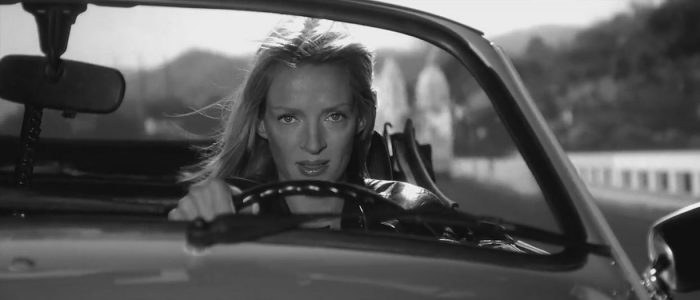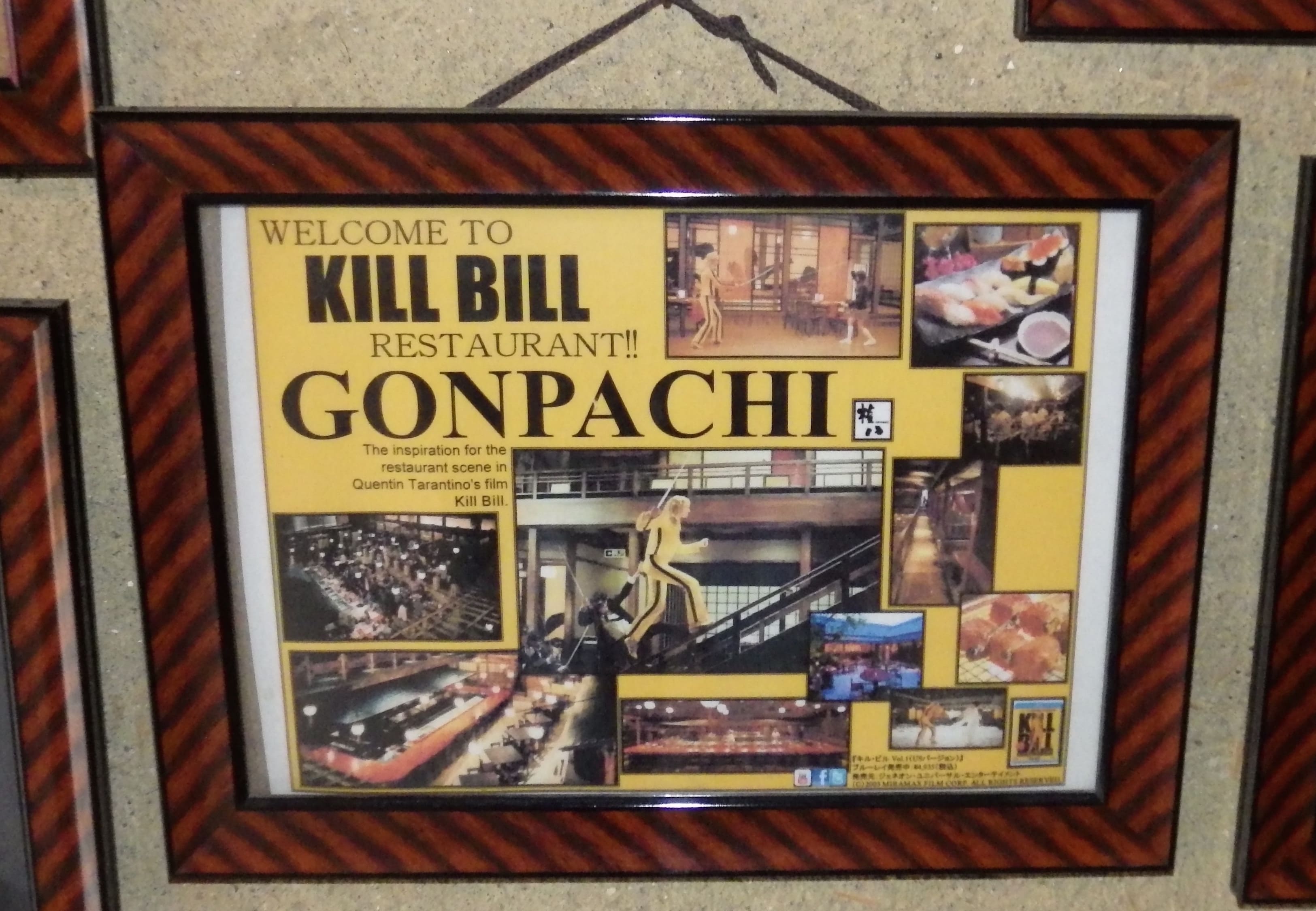'Kill Bill' At 15: How The Bride's 'Survival Energy' Is More Relevant Than Ever
I can pinpoint the exact moment I became a fan of Quentin Tarantino's work. It wasn't in the 1990s, though Tarantino's influence reigned hard that decade and I had an appreciation for his films, if not an outright love for them. No, my conversion came at a theater on opening day, October 10, 2003, when I watched something completely unexpected happened in an early scene of Kill Bill, Vol. 1, starring Uma Thurman.
Being a fan of a celebrity and a fan of his or her work are two different things. That's an important distinction to make in 2018. This time last year, the Harvey Weinstein scandal was just beginning to unfold. As the effect of it spread through Hollywood and the culture at large, Thurman herself would become the subject of a New York Times article revealing a "dark undercurrent that twisted the triangle" of her, Tarantino, and Weinstein. In the midst of a societal paradigm shift, it would renew the debate about separating art from the artist and whether or not that's possible or even appropriate.
Fifteen years later, the character of The Bride, "created by Q & U," or Quentin and Uma, has taken on new meaning as an icon of what Thurman called "survival energy." From the opening shot of Kill Bill, Vol. 1, she's a woman subjected to rough treatment, forced to run a gauntlet of victimizers in an attempt to endure and prevail.
Kill Bill, Vol. 1 opens with a quote teasing Tarantino's favorite theme, revenge. It's a Star Trek reference, the old Klingon proverb, "Revenge is a dish best served cold." The sound of a woman's heavy breathing soon gives way to the sight of Thurman's bruised and bloodied face. She's wearing a wedding veil, whimpering as two menacing cowboy boots clop across the wooden floorboards toward her.
"Do you find me sadistic?" we hear the wearer of those boots ask as he hovers over her. It's a meta first line in that Tarantino's critics have often accused him of sadism and fetishizing violence (along with feet, but that's a different quirk). "There's nothing sadistic in my actions," the voice insists, but the Bride's eyes soon go wide and we hear a gun being loaded. With a plea of, "Bill, it's your baby," the Bride clues us in that she's pregnant ... right as Bill shoots her in the head.
This brutal barnstormer of an opening scene immediately raises the revenge stakes as high as they will go. What comes next is the scene that really sold me (spoilers follow). It's the one where we see the Bride drive up to a house and physically confront the second name on her "death list," Vernita Green, played by Vivica A. Fox. This isn't one of those movies that lacks for meaningful action beats. However, the ensuing knife fight between the Bride and Vernita gets interrupted by a school bus outside the window. Vernita's daughter has come home from school.

Giving their impromptu deathmatch a rest while there's a 4-year-old in the house, they retire to Vernita's kitchen where they engage in something of a verbal dance that is every bit as expertly choreographed as the room-wrecking fight we've just watched. The Bride makes it clear in no uncertain terms that she and Vernita "have unfinished business." It's just a matter of where and when that business will be finished.
Tarantino's "tell-me" dialogue — which manages to be suggestive here like a stage play rather than expository like an info dump — tells us that the finishing-of-business will happen very soon, tonight, in fact. Vernita lays it all out for the Bride and us, painting a vivid picture of how their fight might be concluded. She says:
"There's a baseball diamond where I coach our little league about a mile from here. We meet there around 2:30 in the morning, dressed all in black, your hair in a black stocking. And we have us a knife fight."
Through arch dialogue, the script leads the audience along and then blindsides it with a burst of sudden violence. It's textbook Tarantino. Not long after saying her spiel about the little-league baseball diamond, Vernita whips a gun out of a cereal box in her kitchen. She fires it but misses and the Bride promptly throws a knife into her heart. It's surprising and the viewer extracts a thrill from being caught off-guard with an early-death twist. Of course, the cereal box is labeled, "Kaboom," but I didn't pick up on that the first time I saw the movie, nor did it occur to me that the knife fight Vernita was teasing had already happened right there in her living room.
Building off these two scenes, Kill Bill, Vol. 1 remains the front-loaded first half of Tarantino's most ambitious epic. With its impeccable soundtrack — tunes like Tomayasu Hotei's "Battle Without Honor or Humanity" — making the mere act of walking vogue, it's a samurai revenge film that incorporates and mimics numerous other forms of cinema like anime and spaghetti westerns, per the usual Tarantino style of blending influences. Since her name is bleeped out for effect, we never get to know Thurman's sword-wielding main character as anything other than the Bride in this movie. Yet that only adds to her mythic quality. She's the Bride of all humanity and her quest for vengeance is the Harrowing of Hell.
Before it ends on a juicy cliffhanger, the film crescendos into a blood-geysering set piece where the Bride faces off with a band of assassins, the Crazy 88, led by the Lady-Snowblood-inspired O-Ren Ishii (Lucy Liu). It happens in a nightclub called the House of Blue Leaves. This location was inspired by a real Tokyo venue, where you can find a sign inside the door reading, "Welcome to the Kill Bill restaurant!" Behind a glass case, a framed photo of Tarantino's visit to the restaurant sits proudly with a Kill Bill, Vol. 1 Blu-Ray. It's a veritable Tarantino shrine.
Kill Bill, Vol. 1 is my favorite Tarantino film. Seeing this movie made me worship at the temple of his filmography. With the Kill Bill duology, however, there's now an elephant in the room in light of the revelations made earlier this year through that New York Times article. In it, Thurman outlined her own assault at the hands of Harvey Weinstein, the studio mogul who, prior to his precipitous downfall, acted as the patron for Pulp Fiction and Tarantino's whole blood-soaked oeuvre.
In the narrative of now, it's virtually impossible to watch Kill Bill without thinking on some level about what Thurman went through on the set and before and after production. In the article, she also related how — in what sounds like some warped bit of real-life inspiration for Tarantino's Death Proof — he pressured her into doing a driving stunt that resulted in a car accident where she was seriously hurt. Evidently, he also volunteered to be the actor in places where the script called for someone to spit in her face or choke her with a chain.
Tarantino and Thurman have a 25-year history. Before he linked up with Christoph Waltz, it was always Thurman that was described as Tarantino's muse. The Bride was seen as a symbol of empowerment, one of those great, pre-Gal-Gadot action heroines like Ellen Ripley or Sarah Conner.
It's important to note here that Tarantino has since apologized and Thurman has said she forgives him and would work with him again "if he wrote a great part." Maybe that part could be Kill Bill, Vol. 3. Tarantino has said he will retire after his tenth film and right now he's out there making his ninth, Once Upon a Time in Hollywood, which did cast Thurman's daughter in an unspecified role. Dredging up this year's controversy on the 15th anniversary of Kill Bill, Vol. 1 is, therefore, not an attempt to impugn Tarantino further. Having never met the man, being in no position to judge him as a human being, all I or any other audience member can really do is judge his work.
The phrase "created by Q & U" used to have a double meaning. Now it has a triple meaning. Obviously, the immediate ring it has to it beyond "Quentin and Uma" is that of a storyteller communing with his audience, sharing credit with you, the viewer. Yet in the era of #MeToo, it also has the effect of turning responsibility back on the audience, as if the Bride's "roaring rampage of revenge" — and by extension, the real-life one that has played out partially in the patriarchy this year — is our fault because we let it come to that.

A Quartz analysis released in the wake of the flood of accusations against Harvey Weinstein showed that he was thanked in Academy Award acceptance speeches the same number of times as God. Only Steven Spielberg was thanked more over a fifty-year period.
In a society whose every institution seems riddled with systemic corruption, how many other people in positions of power have received bureaucratic protection from up on high or benefitted from the complicity of rank-and-file subordinates who knowingly helped cover up their transgressions? In this way, the culture itself becomes culpable for enabling abusers, aiding and abetting them by standing by idly, turning a blind eye to their bad behavior, even perhaps rewarding it with golden statuettes.
The Bride is hardly innocent; she's an assassin who kills another assassin turned mother, telling Vernita Green's little girl, "When you grow up, if you still feel raw about it, I'll be waiting." She knows this is her moment yet there also may come a time when she, too, will be taken to account for exceeding the bounds of justice in favor of pure revenge.
In the meantime, the black-and-white scene at the beginning of Kill Bill, Vol. 2, where the Bride is behind the wheel of her car, driving while looking straight into the camera, addressing the audience, seems eerily prescient now, as if she's been on that same road for the last fifteen years and is only just now catching up with Bill, at long last getting close — if not close enough yet — to crossing his name off her death list.


